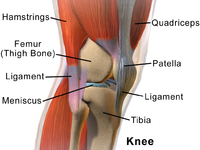
Photo from wikipedia
OBJECTIVE To investigate the incidence of subsequent lumbar spine, hip, and ankle-foot injuries after a diagnosis of patellofemoral pain. DESIGN Retrospective cohort study. SETTING Military Health System. PARTICIPANTS Individuals (n = 92,319)… Click to show full abstract
OBJECTIVE To investigate the incidence of subsequent lumbar spine, hip, and ankle-foot injuries after a diagnosis of patellofemoral pain. DESIGN Retrospective cohort study. SETTING Military Health System. PARTICIPANTS Individuals (n = 92,319) ages 17-60 diagnosed with patellofemoral pain between 2010-2011. INTERVENTIONS Therapeutic exercise. MAIN OUTCOME MEASURES Frequency of adjacent joint injuries in the 2-year period after initial patellofemoral pain injury, and hazard ratios (HR) with 95% confidence interval (CI) and Kaplan-Meier survival curves for risk of adjacent joint injury based on receiving therapeutic exercise for the initial injury. RESULTS After initial patellofemoral pain diagnosis, 42,983 (46.6%) individuals sought care for an adjacent joint injury. Of these, 19,587 (21.2%) were subsequently diagnosed with a lumbar injury, 2837 (3.1%) a hip injury, and 10,166 (11.0%) an ankle-foot injury. One in five (19.5%; n = 17,966) received therapeutic exercise which reduced the risk of having a subsequent lumbar (HR = 0.78, 95% CI 0.76-0.81), hip (HR = 0.93, 95% CI 0.87-0.98) or ankle-foot (HR = 0.86, 95% CI 0.83-0.90) injury. CONCLUSION The results suggest that a high number of individuals with patellofemoral pain will sustain an adjacent joint injury within 2 years although causal relationships cannot be determined. Receiving therapeutic exercise for the initial knee injury reduced the risk of sustaining an adjacent joint injury. This study helps provide normative data for subsequent injury rates in this population and guide development of future studies designed to understand causal factors.
Journal Title: Clinical rehabilitation
Year Published: 2023
Link to full text (if available)
Share on Social Media: Sign Up to like & get
recommendations!